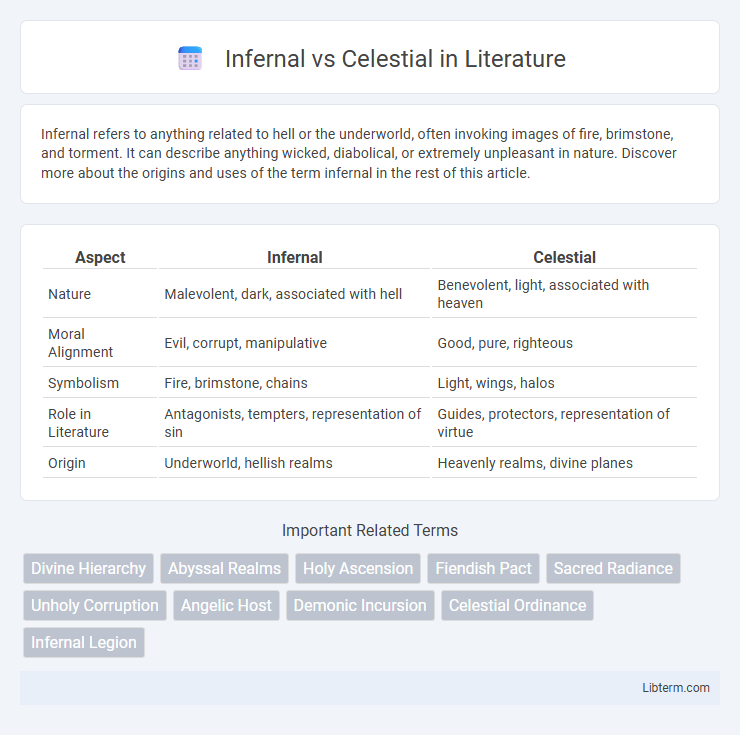Infernal refers to anything related to hell or the underworld, often invoking images of fire, brimstone, and torment. It can describe anything wicked, diabolical, or extremely unpleasant in nature. Discover more about the origins and uses of the term infernal in the rest of this article.
Table of Comparison
| Aspect | Infernal | Celestial |
|---|---|---|
| Nature | Malevolent, dark, associated with hell | Benevolent, light, associated with heaven |
| Moral Alignment | Evil, corrupt, manipulative | Good, pure, righteous |
| Symbolism | Fire, brimstone, chains | Light, wings, halos |
| Role in Literature | Antagonists, tempters, representation of sin | Guides, protectors, representation of virtue |
| Origin | Underworld, hellish realms | Heavenly realms, divine planes |
Introduction to Infernal and Celestial Concepts
Infernal and Celestial entities represent opposing forces in metaphysical and fantasy lore, with Infernal beings embodying chaos, darkness, and malevolence, often associated with hellish realms and demonic hierarchies. Celestial entities, by contrast, symbolize order, light, and virtue, originating from divine spheres and serving as guardians or agents of higher powers. Understanding these concepts involves exploring their roles in moral dualism, cosmology, and influence on human beliefs about good and evil.
Historical Origins and Mythological Roots
Infernal and Celestial beings originate from ancient mythologies where Infernal entities are typically linked to the underworld and darkness, embodying themes of punishment and chaos often rooted in Hell-like realms from Greco-Roman and Christian traditions. Celestial beings are associated with the heavens, light, and divine order, frequently represented as angels or gods in mythologies such as Zoroastrianism, Christianity, and Hinduism, symbolizing purity and protection. The historical origins of these concepts reflect humanity's attempt to explain moral dualism and the cosmic struggle between good and evil.
Core Characteristics: Infernal vs Celestial
Infernal beings embody darkness, chaos, and malevolence, often associated with fire, brimstone, and torment in their core characteristics. Celestial entities represent light, order, and benevolence, characterized by purity, healing, and divine justice. The contrast between Infernal and Celestial centers around their fundamental alignment: Infernal correlates with evil and corruption, while Celestial aligns with good and righteousness.
Symbolism in Religion and Culture
Infernal symbolism often represents chaos, punishment, and moral corruption, serving as a powerful emblem of evil and sin in various religious texts and cultural narratives. Celestial symbolism conveys purity, divine order, and enlightenment, frequently associated with gods, angels, and heavenly realms in spiritual traditions and myths. These opposing symbols shape humanity's understanding of good versus evil, influencing rituals, morality, and artistic expressions across cultures worldwide.
Representation in Literature and Art
Infernal and celestial beings have been prominently depicted in literature and art, symbolizing the eternal conflict between good and evil. Infernal entities often embody chaos and punishment in works ranging from Dante's "Inferno" to Milton's "Paradise Lost," with dark, grotesque imagery, while celestial figures represent divine order and salvation through inspiring, radiant iconography in Christian art and epic poetry. These contrasting representations underscore humanity's exploration of morality, spirituality, and the afterlife across cultural narratives.
Infernal and Celestial Entities: Key Examples
Infernal entities include demons such as Asmodeus and Belial, known for their malevolent influence in mythologies and role-playing games like Dungeons & Dragons. Celestial beings often feature angels like Michael and Gabriel, symbolizing divine protection and righteousness across various religious texts. The contrast between Infernal and Celestial exemplifies the classic dichotomy of evil versus good within many cultural narratives.
Moral Duality: Good, Evil, and the Grey
Infernal beings embody absolute evil, representing corruption, temptation, and moral degradation, while Celestial entities symbolize purity, virtue, and the unwavering pursuit of good. The clash between these forces highlights the stark moral duality often depicted in mythology and storytelling, emphasizing the eternal struggle between light and darkness. However, narratives also explore the grey areas where infernal and celestial motivations blur, revealing complex characters driven by conflicting desires and ambiguous morals.
Influence on Modern Media and Pop Culture
Infernal and Celestial themes heavily influence modern media and pop culture, shaping character archetypes, narratives, and world-building in genres like fantasy, horror, and superhero fiction. Infernal elements often embody chaos, temptation, and moral conflict, inspiring villains and antiheroes in films, games, and literature, while Celestial motifs represent purity, protection, and enlightenment, frequently depicted through angels, divine beings, and utopian realms. This duality enriches storytelling by exploring the tension between good and evil, reflecting timeless human struggles and ethical dilemmas in a visually and thematically compelling way.
Comparative Analysis: Strengths and Weaknesses
Infernal beings excel in manipulation and resilience, utilizing dark magic to corrupt and control, yet their reliance on fear often undermines long-term alliances. Celestial entities possess radiant power and healing abilities, promoting order and protection, though their strict adherence to laws can limit adaptability in chaotic environments. The infernal's cunning contrasts with the celestial's discipline, creating a dynamic where strategic deceit meets unwavering righteousness.
Conclusion: Lasting Impact and Future Perspectives
Infernal and Celestial forces shape diverse mythologies and literature by embodying themes of chaos versus order and corruption versus purity, influencing cultural narratives and moral frameworks. Their lasting impact is evident in modern storytelling, where these archetypes continue to inspire character development, ethical dilemmas, and world-building elements across fantasy genres. Future perspectives suggest an evolving interpretation of these entities, incorporating contemporary issues and psychological depth to enrich their symbolic resonance and relevance.
Infernal Infographic

 libterm.com
libterm.com